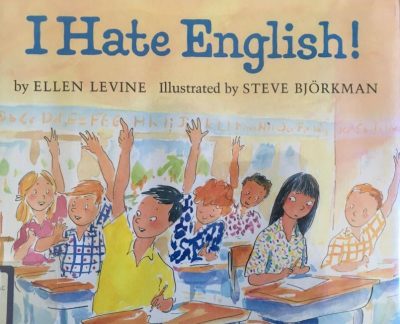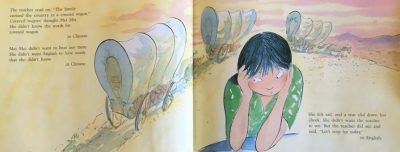
Author: Ellen Levine
Illustrator: Steve Bjorkman
Publisher and Year: Scholastic Inc., 1989
Number of pages: 32
Tags: 2-3, 4-5 Fiction, Diversity, Culture, Amy Sanchez
Analysis: This book is about a young girl named Mei Mei who just moved to the United States from Hong Kong. She could understand some English but didn’t want to speak it. She is disinterested in learning and speaking English. She feels as though learning English would make her forget Chinese, leaving her family and culture behind. Mei Mei meets Nancy, a teacher, who insist on helping her become more comfortable with speaking English. Nancy takes her on a walking trip where she won’t stop talking until Mei Mei becomes annoyed that she bursts out talking in English. This experience helped Mei Mei realize that she can have both cultures and languages. Learning a new language doesn’t mean forgetting and laving behind the other one.
This book can serve as window to understand the feelings that that ELL students experience in the process of learning a new language. This book portrayed the difficulties of a young girl understanding to embrace her culture as well as learning English. This book can also serve as a mirror for multicultural children who are learning to embrace their cultural identity and maybe struggling to understand that they can have both their own culture and the American one without leaving one or the other behind.. As previously mentioned, the book portrays the struggle of a young Chinese-American girl who is trying to straddle two cultures. This story is one that illustrates how America is diverse and how some people speak more than one language. This book can also be a door to teach children about different languages and their cultural significance. Our country has so many cultures with each a different language, and no one language is better or the right one to practice.
The ideology this book explores is the idea of bilingualism. There is a buildup of frustration throughout the book, as the little girl expresses her disinterest in learning English. However, the girl is pleasantly surprised when she realizes that she can speak English and Chinese without losing her own culture.
The illustrations used in this book use an open frame, so our view is from the outside.. They help illustrate both cultures. For many of the pages, the little girl is positioned on the left side, meaning she is more secure. For some of the illustrations the young girl is facing away or facing down. Those illustrations help portray her frustration. They help convey those emotions. The illustrations help capture the emotions the little girl is experiencing. The illustrator used jagged lines that convey the message of trouble emotions. The illustrations used capillarity which looked like thin squiggly like capillaries that signaled nervousness.
